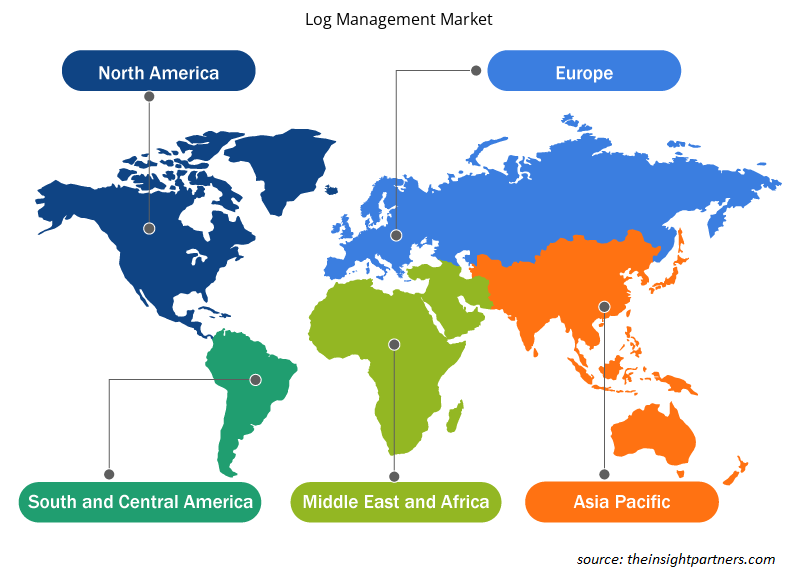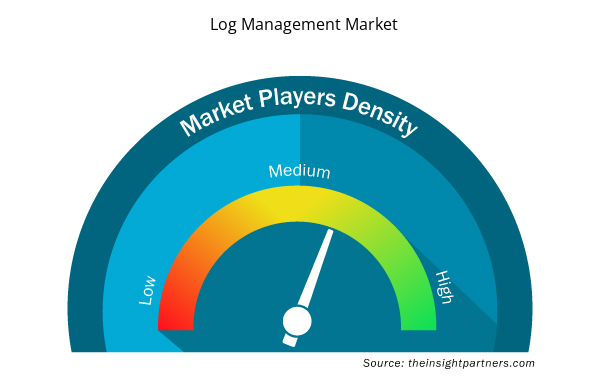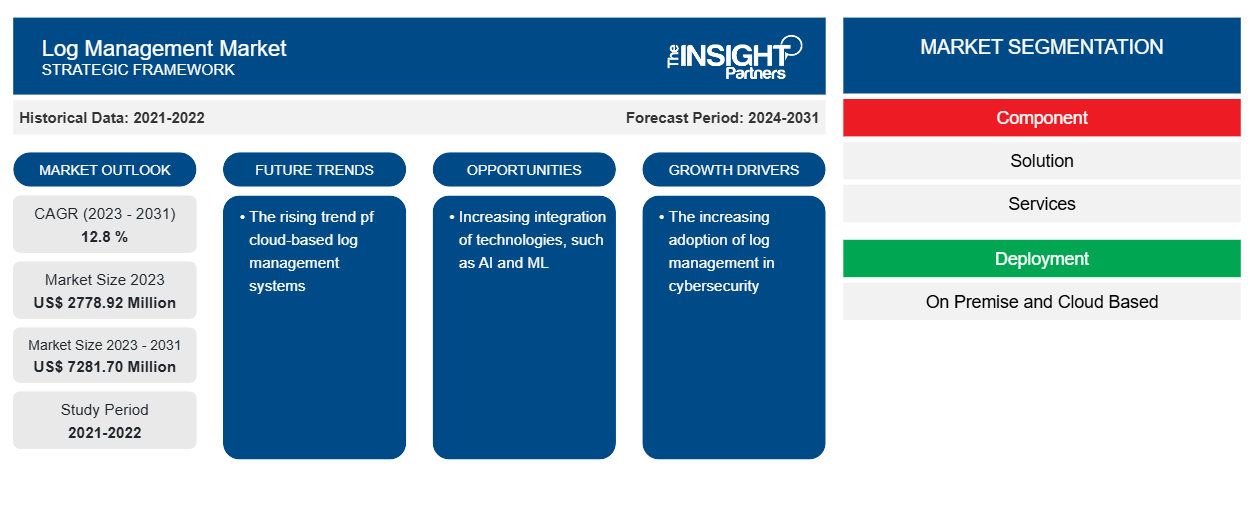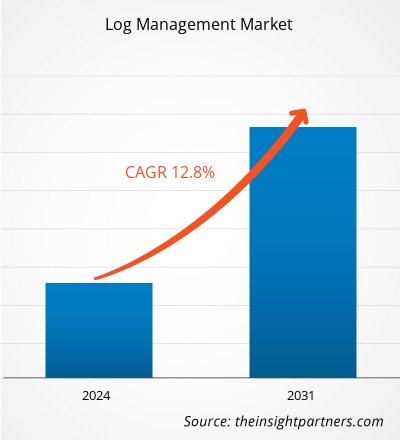ログ管理市場規模は、2023年の27億7,892万米ドルから2031年には72億8,170万米ドルに達すると予測されています。市場は2023年から2031年の間に12.8%のCAGRを記録すると予想されています。クラウドベースのログ管理システムの増加傾向は、市場の主要なトレンドであり続けると思われます。
ログ管理市場分析
クラウドベースのログ管理プラットフォームの増加傾向は、導入コストと導入時間の短縮とシンプルさにより、ログ管理市場の成長を牽引しています。クラウドベースのログ管理プラットフォームは、メンテナンスと修理の費用を削減し、顧客満足度を向上させます。したがって、クラウドベースのログ管理プラットフォームのさまざまな利点により、サイバー攻撃の早期検出のためにプラットフォームの採用が増加しており、ログ管理市場の成長を促進しています。
ログ管理市場の概要
ログ管理とは、システム パフォーマンスの向上、リソースの管理の改善、技術的問題の特定、セキュリティの強化、コンプライアンスの向上を目的として、さまざまなプログラムやアプリケーションからのデータを継続的に処理、保存、収集、分析、統合する手法です。ログ管理システム (LMS) は、さまざまなソースからのログ データを 1 か所で分類、収集、イベント ログし、保存するソフトウェア ソリューションです。IT チーム、DevOps、SecOps の専門家は、関連するすべてのネットワーク データとアプリケーション データを取得できる単一のポイントを見つけることができます。通常、このログ ファイルは完全に検索可能でインデックス化されているため、IT チームはネットワークの健全性、リソースの割り当て、セキュリティに関する決定を下すために必要なデータにアクセスできます。
要件に合わせてレポートをカスタマイズする
このレポートの一部、国レベルの分析、Excelデータパックなど、あらゆるレポートを無料でカスタマイズできます。また、スタートアップや大学向けのお得なオファーや割引もご利用いただけます。
- このレポートの主要な市場動向を入手してください。この無料サンプルには、市場動向から見積もりや予測に至るまでのデータ分析が含まれます。
ログ管理市場の推進要因と機会
サイバーセキュリティにおけるログ管理の採用増加
ログ管理は、サイバーセキュリティと IT 運用の基本要素です。組織の IT インフラストラクチャ内のさまざまなシステム、アプリケーション、デバイスからログ データを収集、保存、分析、監視することを目的とした一連の重要なタスクが含まれます。IT インフラストラクチャのこの側面は見落とされがちですが、デジタル資産のセキュリティ、パフォーマンス、コンプライアンスを維持する上で重要な要素です。そのため、サイバーセキュリティにおけるログ管理の採用が増え、ログ管理市場が成長しています。
AIやMLなどの技術の統合の拡大
テクノロジーが進歩するにつれ、データ チームは AI と ML の力を活用してログ ファイルを読み取って理解できるようになります。このプロセスを通じて、システム問題の根本原因を簡単に特定したり、将来のエラーを予測したりすることができます。機械学習と人工知能は、データと予測分析と同義で使われることがよくあります。ただし、機械学習は、機械が経験から学習できるようにする AI のコンポーネントにすぎません。使用するデータが多いほど、モデルは向上します。したがって、AI や ML などのテクノロジーの統合が進むにつれて、市場にはより多くの機会が生まれています。
ログ管理市場レポートのセグメンテーション分析
ログ管理市場分析の導出に貢献した主要なセグメントは、コンポーネント、展開、および組織の規模です。
- ログ管理市場は、コンポーネントに基づいてソリューションとサービスに分かれています。ソリューションセグメントは、2023年に大きな市場シェアを占めました。
- 展開によって、市場はオンプレミスとクラウドベースに分類されます。
- 組織の規模によって、市場は中小企業と大企業に分類されます。
- 業界別に見ると、市場はITおよび通信、BFSI、 ヘルスケア、教育、小売および電子商取引、その他に分類されています。BFSI,
地域別のログ管理市場シェア分析
ログ管理市場レポートの地理的範囲は、主に北米、アジア太平洋、ヨーロッパ、中東およびアフリカ、南米および中米の 5 つの地域に分かれています。
ログ管理市場は北米が支配しています。オープンソースのログ管理プラットフォームが利用可能になったことで、有料のログ管理サービスの需要が制限され、ログ管理市場全体に影響を与えています。オープンソースのログ管理プラットフォームを採用することで、企業は有料のログ管理プラットフォームに関連するベンダーロックイン期間も短縮できます。Logstash、Fluentd、GoAccess、および LOGalyze はすべてオープンソースのログ管理プラットフォームです。そのため、APAC 地域ではログ管理システムの需要が高まっています。Logstash, Fluentd, GoAccess, and LOGalyze are all open-source log management platforms. Thus, the demand for log management systems is increasing in the APAC region.
ログ管理市場の地域別分析
予測期間を通じてログ管理市場に影響を与える地域的な傾向と要因は、Insight Partners のアナリストによって徹底的に説明されています。このセクションでは、北米、ヨーロッパ、アジア太平洋、中東およびアフリカ、南米および中米にわたるログ管理市場のセグメントと地理についても説明します。

- ログ管理市場の地域別データを入手
ログ管理市場レポートの範囲
| レポート属性 | 詳細 |
|---|---|
| 2023年の市場規模 | 27億7,892万米ドル |
| 2031年までの市場規模 | 72億8,170万米ドル |
| 世界のCAGR(2023年~2031年) | 12.8 % |
| 履歴データ | 2021-2022 |
| 予測期間 | 2024-2031 |
| 対象セグメント | コンポーネント別
|
| 対象地域と国 | 北米
|
| 市場リーダーと主要企業プロフィール |
|
ログ管理市場のプレーヤー密度: ビジネスダイナミクスへの影響を理解する
ログ管理市場は、消費者の嗜好の変化、技術の進歩、製品の利点に対する認識の高まりなどの要因により、エンドユーザーの需要が高まり、急速に成長しています。需要が高まるにつれて、企業は提供内容を拡大し、消費者のニーズを満たすために革新を起こし、新たなトレンドを活用し、市場の成長をさらに促進しています。
市場プレーヤー密度とは、特定の市場または業界内で活動している企業または会社の分布を指します。これは、特定の市場スペースに、その市場規模または総市場価値に対してどれだけの競合相手 (市場プレーヤー) が存在するかを示します。
ログ管理市場で事業を展開している主要企業は次のとおりです。
- アラートロジック
- シスコシステムズ
- 株式会社
- IBMコーポレーション
- データドッグ
- ログリズム
免責事項:上記の企業は、特定の順序でランク付けされていません。

- ログ管理市場のトップキープレーヤーの概要を入手
ログ管理市場のニュースと最近の動向
ログ管理市場は、主要な企業出版物、協会データ、データベースなどの一次調査と二次調査後の定性的および定量的データを収集することによって評価されます。ログ管理市場の動向のいくつかを以下に示します。
- Microsoft は、連邦政府機関のサイバーコンプライアンスの加速を支援する最新のログ管理プログラムを開始しました (出典: Microsoft、プレスリリース、2022 年 2 月)。
- Trimble は、製材所の原材料調達を管理するために広く使用されている丸太在庫管理システム (LIMS) の新しいクラウドホストバージョンである LIMS PRO のリリースを発表しました。クラウドベースの丸太決済ソリューションである LIMS PRO は、製材所の運用可視性を向上させるように設計されています。これにより、中小規模の林業企業は、木材サプライチェーンのワークフローをデジタル化することで、これまで大企業のみが実現できた生産性と成長の向上を実現できます。(出典: Trimble、プレスリリース、2023 年 7 月)
ログ管理市場レポートの対象範囲と成果物
「ログ管理市場の規模と予測(2021〜2031年)」レポートでは、以下の分野をカバーする市場の詳細な分析を提供しています。
- ログ管理市場の規模と予測(世界、地域、国レベルで)
- ログ管理市場の動向、推進要因、制約、主要な機会などの市場動向
- 詳細なPEST/ポーターの5つの力とSWOT分析
- 主要な市場動向、世界および地域の枠組み、主要プレーヤー、規制、最近の市場動向を網羅したログ管理市場分析
- 市場集中、ヒートマップ分析、主要プレーヤー、ログ管理市場の最近の動向を網羅した業界の状況と競争分析
- 詳細な企業プロフィール
- 過去2年間の分析、基準年、CAGRによる予測(7年間)
- PEST分析とSWOT分析
- 市場規模価値/数量 - 世界、地域、国
- 業界と競争環境
- Excel データセット



Report Coverage
Revenue forecast, Company Analysis, Industry landscape, Growth factors, and Trends

Segment Covered
This text is related
to segments covered.

Regional Scope
North America, Europe, Asia Pacific, Middle East & Africa, South & Central America

Country Scope
This text is related
to country scope.
よくある質問
The expected CAGR of the global log management market is 12.8 %.
The global log management market is expected to reach US$ 7281.70 million by 2031.
The key players holding majority shares in the global log management market are Alert Logic, Cisco Systems, Inc., IBM Corporation, Datadog, LogRhythm, Inc., Splunk, Inc., ManageEngine, SolarWinds Worldwide, Sematext Group Inc., and AT&T Inc.
The rising trend of cloud-based log management systems is anticipated to play a significant role in the global log management market in the coming years.
The increasing adoption of log management in cybersecurity and Increasing integration of technologies, such as AI and ML, are the major factors that propel the global log management market.
North America dominates the log management market.
Trends and growth analysis reports related to Technology, Media and Telecommunications : READ MORE..
The Insight Partners performs research in 4 major stages: Data Collection & Secondary Research, Primary Research, Data Analysis and Data Triangulation & Final Review.
- Data Collection and Secondary Research:
As a market research and consulting firm operating from a decade, we have published and advised several client across the globe. First step for any study will start with an assessment of currently available data and insights from existing reports. Further, historical and current market information is collected from Investor Presentations, Annual Reports, SEC Filings, etc., and other information related to company’s performance and market positioning are gathered from Paid Databases (Factiva, Hoovers, and Reuters) and various other publications available in public domain.
Several associations trade associates, technical forums, institutes, societies and organization are accessed to gain technical as well as market related insights through their publications such as research papers, blogs and press releases related to the studies are referred to get cues about the market. Further, white papers, journals, magazines, and other news articles published in last 3 years are scrutinized and analyzed to understand the current market trends.
- Primary Research:
The primarily interview analysis comprise of data obtained from industry participants interview and answers to survey questions gathered by in-house primary team.
For primary research, interviews are conducted with industry experts/CEOs/Marketing Managers/VPs/Subject Matter Experts from both demand and supply side to get a 360-degree view of the market. The primary team conducts several interviews based on the complexity of the markets to understand the various market trends and dynamics which makes research more credible and precise.
A typical research interview fulfils the following functions:
- Provides first-hand information on the market size, market trends, growth trends, competitive landscape, and outlook
- Validates and strengthens in-house secondary research findings
- Develops the analysis team’s expertise and market understanding
Primary research involves email interactions and telephone interviews for each market, category, segment, and sub-segment across geographies. The participants who typically take part in such a process include, but are not limited to:
- Industry participants: VPs, business development managers, market intelligence managers and national sales managers
- Outside experts: Valuation experts, research analysts and key opinion leaders specializing in the electronics and semiconductor industry.
Below is the breakup of our primary respondents by company, designation, and region:

Once we receive the confirmation from primary research sources or primary respondents, we finalize the base year market estimation and forecast the data as per the macroeconomic and microeconomic factors assessed during data collection.
- Data Analysis:
Once data is validated through both secondary as well as primary respondents, we finalize the market estimations by hypothesis formulation and factor analysis at regional and country level.
- Macro-Economic Factor Analysis:
We analyse macroeconomic indicators such the gross domestic product (GDP), increase in the demand for goods and services across industries, technological advancement, regional economic growth, governmental policies, the influence of COVID-19, PEST analysis, and other aspects. This analysis aids in setting benchmarks for various nations/regions and approximating market splits. Additionally, the general trend of the aforementioned components aid in determining the market's development possibilities.
- Country Level Data:
Various factors that are especially aligned to the country are taken into account to determine the market size for a certain area and country, including the presence of vendors, such as headquarters and offices, the country's GDP, demand patterns, and industry growth. To comprehend the market dynamics for the nation, a number of growth variables, inhibitors, application areas, and current market trends are researched. The aforementioned elements aid in determining the country's overall market's growth potential.
- Company Profile:
The “Table of Contents” is formulated by listing and analyzing more than 25 - 30 companies operating in the market ecosystem across geographies. However, we profile only 10 companies as a standard practice in our syndicate reports. These 10 companies comprise leading, emerging, and regional players. Nonetheless, our analysis is not restricted to the 10 listed companies, we also analyze other companies present in the market to develop a holistic view and understand the prevailing trends. The “Company Profiles” section in the report covers key facts, business description, products & services, financial information, SWOT analysis, and key developments. The financial information presented is extracted from the annual reports and official documents of the publicly listed companies. Upon collecting the information for the sections of respective companies, we verify them via various primary sources and then compile the data in respective company profiles. The company level information helps us in deriving the base number as well as in forecasting the market size.
- Developing Base Number:
Aggregation of sales statistics (2020-2022) and macro-economic factor, and other secondary and primary research insights are utilized to arrive at base number and related market shares for 2022. The data gaps are identified in this step and relevant market data is analyzed, collected from paid primary interviews or databases. On finalizing the base year market size, forecasts are developed on the basis of macro-economic, industry and market growth factors and company level analysis.
- Data Triangulation and Final Review:
The market findings and base year market size calculations are validated from supply as well as demand side. Demand side validations are based on macro-economic factor analysis and benchmarks for respective regions and countries. In case of supply side validations, revenues of major companies are estimated (in case not available) based on industry benchmark, approximate number of employees, product portfolio, and primary interviews revenues are gathered. Further revenue from target product/service segment is assessed to avoid overshooting of market statistics. In case of heavy deviations between supply and demand side values, all thes steps are repeated to achieve synchronization.
We follow an iterative model, wherein we share our research findings with Subject Matter Experts (SME’s) and Key Opinion Leaders (KOLs) until consensus view of the market is not formulated – this model negates any drastic deviation in the opinions of experts. Only validated and universally acceptable research findings are quoted in our reports.
We have important check points that we use to validate our research findings – which we call – data triangulation, where we validate the information, we generate from secondary sources with primary interviews and then we re-validate with our internal data bases and Subject matter experts. This comprehensive model enables us to deliver high quality, reliable data in shortest possible time.


 このレポートの無料サンプルを入手する
このレポートの無料サンプルを入手する